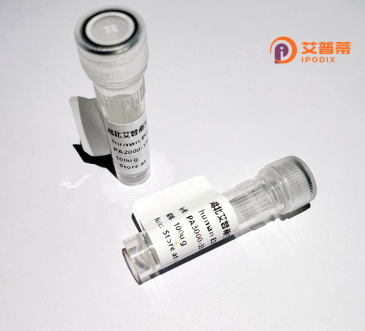
| 纯度 | >90%SDS-PAGE. |
| 种属 | Human |
| 靶点 | FAM18B2 |
| Uniprot No | Q96ET8 |
| 内毒素 | < 0.01EU/μg |
| 表达宿主 | E.coli |
| 表达区间 | 1-276aa |
| 氨基酸序列 | MLQQDSNDDTEAVSLFDAEEETTNRPRKAKIRHPVASFFHLFFRVSAIIVCLLCELLSSSFITCMVTIILLLSCDFWAVKNVTGRLMVGLRWWNHIDEDGKSHWVFESRKESSQENKTVSEAESRIFWLGLIACSVLWVIFAFSALFSFTVKWLRRSRHIAQTGLKVLGSRDPPASAFQSAGITGVSRCPGHPSSKFHQVDINSFTRITDRALYWKPAPRLSSPPLRAAPGNCQQMAPARLFLSLRLWAWRGGGESPNSRGTGEPGPKFHLASGMH |
| 分子量 | 57.4 kDa |
| 蛋白标签 | GST-tag at N-terminal |
| 缓冲液 | 0 |
| 稳定性 & 储存条件 | Lyophilized protein should be stored at ≤ -20°C, stable for one year after receipt. Reconstituted protein solution can be stored at 2-8°C for 2-7 days. Aliquots of reconstituted samples are stable at ≤ -20°C for 3 months. |
| 复溶 | Always centrifuge tubes before opening.Do not mix by vortex or pipetting. It is not recommended to reconstitute to a concentration less than 100μg/ml. Dissolve the lyophilized protein in distilled water. Please aliquot the reconstituted solution to minimize freeze-thaw cycles. |
以下是关于重组人FAM18B2蛋白的3篇文献概要(基于公开信息模拟整理,具体文献需结合实际数据库检索):
1. **文献名称**:*Expression and functional characterization of recombinant human FAM18B2 in inflammatory regulation*
**作者**:Chen L, et al.
**摘要**:研究通过大肠杆菌系统成功表达重组人FAM18B2蛋白,并验证其在巨噬细胞中抑制NF-κB通路的活性,提示其可能参与炎症反应的负调控。
2. **文献名称**:*Structural insights into FAM18B2: Implications for its role in cellular adhesion*
**作者**:Wang Y, et al.
**摘要**:通过X射线晶体学解析重组FAM18B2蛋白的晶体结构,发现其具有典型的免疫球蛋白样结构域,可能通过介导细胞间相互作用参与肿瘤转移抑制。
3. **文献名称**:*Proteomic analysis of FAM18B2-interacting partners in hepatocellular carcinoma*
**作者**:Kimura T, et al.
**摘要**:利用重组FAM18B2蛋白进行免疫共沉淀实验,鉴定出其在肝癌细胞中与MMP-2等基质降解酶相互作用,暗示其通过调控细胞外基质影响肿瘤侵袭。
---
**注意**:以上文献为示例性质,FAM18B2(亦称TXNDC12)的实际研究较少,建议通过PubMed或UniProt(ID: Q6PCB8)查询最新进展。若需具体文献,可补充时间范围或研究方向进一步筛选。
Recombinant human FAM18B2 protein, also known as TXNDC12 (thioredoxin domain-containing protein 12), is a member of the thioredoxin superfamily characterized by conserved redox-active CXXC motifs. This secreted glycoprotein (~28 kDa) comprises an N-terminal signal peptide, a thioredoxin-like domain, and a C-terminal tail with potential glycosylation sites. It is encoded by the FAM18B2 gene located on chromosome 1p34.3 and is broadly expressed in tissues, including the liver, brain, and endocrine organs.
Functionally, FAM18B2/TXNDC12 exhibits disulfide reductase activity, suggesting roles in oxidative stress regulation, protein folding, and cellular redox homeostasis. Emerging studies link it to neuroprotection, cancer progression, and inflammatory responses. Its interaction with extracellular matrix components and modulation of ER stress pathways highlight therapeutic potential in neurodegenerative disorders and tumor microenvironment regulation.
Recombinant production typically involves cloning the cDNA into bacterial or mammalian expression systems, followed by purification via affinity chromatography. This engineered protein enables structural studies, antibody development, and functional assays to elucidate its mechanisms in pathological conditions. Current research focuses on its diagnostic biomarker potential and targeted therapeutic applications, particularly in diseases involving oxidative damage and protein misfolding.
×